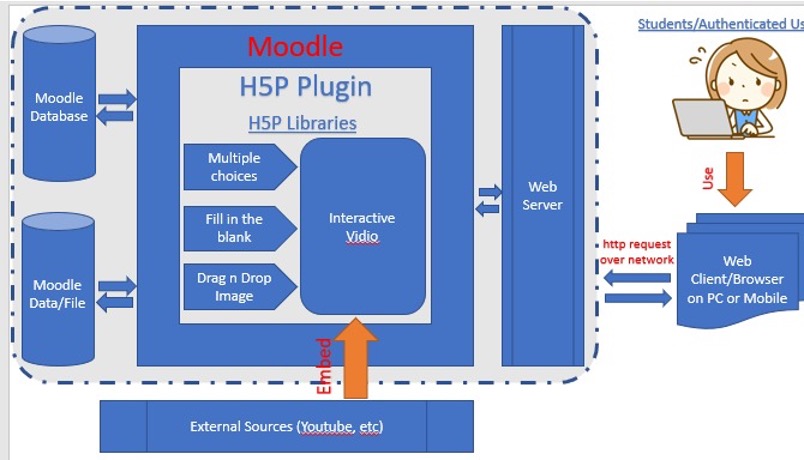
2024 VOL. 11, No. 1
Abstract: The end of the pandemic era has brought new changes and challenges to lectures held in a blended learning environment, one of which is the use of interactive content. The objective of this study was to analyse, develop and evaluate the presentation of content using H5P in blended learning, its relevance to lecture topics, activities to achieve learning outcomes using the rotation-type blended learning model and how students perceive it after using this H5P content. It focused on the rotation model that is commonly used in blended learning. However, this model has not included H5P much yet. The sampling method was purposive. The data were collected using a Likert scale questionnaire. The questionnaire data were examined using the bivariate Pearson correlation approach. The results of this study indicated that the use of H5P as a supporting component in implementing the rotation model type of integrated learning increases student knowledge, skill and satisfaction. Lecturers can apply H5P-based content as content support in blended learning for other study programmes by following the content development steps, type rotation scenario and how the H5P interactive videos are used.
Keywords: blended learning, H5P, interactive content, Learning Management System, rotation model
Since the Covid-19 epidemic in 2020, e-learning has swiftly evolved into a learning model. According to experts, the epidemic altered many aspects of human existence, including schooling. Prior to the pandemic, all school activities were carried out in schools (face-to-face); during the pandemic, all school activities were carried out remotely (online and offline); and after the pandemic, school activities could be carried out in combination (blended learning), face-to-face, online and offline. This was seen as a useful variant for both students and teachers (Drysdale et al., 2013). In other words, post-pandemic learning paradigms, particularly blended learning, will likely remain an option. A Learning Management System (LMS) is one type of this learning approach that has been implemented at universities before, during and after the epidemic.
The use of an LMS has seen significant development, particularly since 2020 due to the Covid-19 pandemic, which curtailed face-to-face teaching options for many educational institutions worldwide (Costa Dias et al., 2020). As reported by Alexe et al. (2021), in an international software review and selection platform, there were 561 LMSs accessible globally for academic and educational applications. Moodle was the most popular and preferred open-source LMS, according to recent systematic research on LMS usage trends (Altinpulluk & Kesim, 2021). Recent research examined the influence of LMSs on students' performance in educational assessment and evaluation and recommended that lecturers learn about and use LMSs such as Moodle (Oguguo et al., 2021).
In this study context, Moodle is also used in computer-based instruction (CBI) but this subject requires several tasks. The CBI material is difficult for both lecturers and students. One of the problems relates to innovation and creativity (Clark & Mayer, 2016). In terms of Bloom's taxonomy, creating these media has reached its greatest degree, namely production (Adams, 2015). Various studies have found that producing CBI media is still difficult because many developers do not understand its concepts and principles, including media rules, media models and media procedures (Rohman et al., 2019: Akram et al., 2012). Researchers have used a variety of techniques to tackle this challenge, allowing learners to go to the highest level in Bloom's taxonomy. This study was inspired by several studies on the effectiveness of blended learning in increasing student engagement, improving creative and critical thinking abilities and assisting in the achievement of learning objectives (Rahmi et al., 2022; Syafril et al., 2022). Researchers have also demonstrated it in several blended learning classrooms (Rahmi et al., 2022; Rahmi & Azrul, 2022); Bentri et al., 2016). This is neither optimal nor adequate, since the course learning outcomes have not been fully realised. There is still a need to provide digital learning content following instructional message design (Fleming, 1993; Rahmi et al., 2017; Rahmi & Azrul, 2021a), so that students have a range of learning options.
The CBI course was taught in a blended learning format that included various activities and relevant information to help students accomplish the learning objectives. The findings of the university's review, via the Internal Executive Information System, revealed that student scores remained low. The researchers then investigated the Moodle plugin, which could still be modified to meet the needs of students and the demands of lecturers, allowing them to complete their learning objectives in certain areas. One of the most recent materials offered in this course was interactive content from the H5P plugin for Moodle, which was the learning management system (LMS) of choice. Several studies have demonstrated the usefulness of employing H5P to promote interaction and student knowledge of information in certain disciplines (Mir, 2021; Dhini & Ardiasih, 2021; Ti-Shen & Sen, 2019). However, the procedure for developing H5P-based content was not explained in detail. In this study, the procedure is outlined in a flowchart so that readers can follow it to develop H5P-based interactive content.
This study investigated the use of H5P for content presentation, its relevance to the topic of lectures, and the efficacy of H5P activities to accomplish learning goals utilising in a blended learning type of rotation model. In this study, many blended learning frameworks with rotation model types were chosen as guides (Dhini & Ardiasih, 2021; Sobchenko, 2021). However, there are still restrictions and incompatibilities with the substance and context of CBI. Steps are then chosen or adapted from the framework to reflect the qualities of the students and the features of the CBI content. In the use of H5P, this study suggests a rotation model framework that is appropriate for student and material characteristics in CBI. As a result of the foregoing comparison of the syntax of the rotation model, the courses in this study were divided into three categories: the lecturer group with the lecturer in the class, collaborative working with small groups and independently using an LMS. This class is changed on a weekly basis.
Most of the issues encountered were due to the students' then current knowledge. In contrast to the traditional teacher-centred learning method, blended learning with the integration of interactive H5P media is a method used to improve student learning by strengthening students' independent learning outside the classroom and active learning while in the classroom (Truitt & Ku, 2018; Giannakos et al., 2018) and through interactive instruction. When learning in class, students can focus on learning activities that interact with lecturers to clarify previous activities. Consequently, it is more successful in areas such as addressing conceptual misconceptions and helping students organise their learning and obtain meaningful learning. (Wang, 2017; Dewan & Steeleworthy, 2013; Mestre, 2012). Thus, this research engages with optimising the effectiveness of interactive content with H5P for the Moodle learning management system in blended learning
This study was purposed to analyse, develop and evaluate H5P-based interactive content used in a blended learning environment. It dealt with a rotation model that is commonly used in blended learning. However, this model has not been as much included in H5P yet.
Moodle is widely used in the community and in many institutions, and it offers a diverse range of active courses in several languages (Al-Ajlan & Zedan, 2008; Sergis & Sampson, 2017). The H5P plugin is a Version 5 HTML framework for displaying interactive content (Benkada & Moccozet, 2017; Dhini & Ardiasih, 2021). H5P may be configured to display interactive content. H5P provides a wide range of activities, including interactive presentations, interactive films, quizzes and other interactive media (Singh & Scholz, 2019). There are now 12 distinct types of annotations available, encompassing semantic and activity categories (Benkada & Moccozet, 2017). This interaction may be built separately by each lecturer based on the specifics of the content and user demands.
The current research position is based on previous research conducted by other researchers such as the integration of H5P activities in Moodle and its implications for learning (Mir, 2021). The integration provides a new experience for users in distance learning. Because technology can provide a different touch in distance learning (Otamas et al., 2021). The use of H5P in learning has been carried out in various fields including the effect of H5p on learning effectiveness. H5P is proven to increase student engagement as a user (Jacob & Centofanti, 2023). This engagement allows H5P content to provide insights to improve the user experience (Hensen & Kühlem, 2023). Various types of online interactive learning content can be used in online learning to increase learner motivation (Gil-García et al., 2023). Other research has also explored the accessibility features of H5P content and provided recommendations for creating inclusive interactive content (Singh & Scholz, 2019).
From these studies, it can be seen that H5P has been widely used in online learning, and has a role in improving student experience and interactivity. However, no one has examined the use of the H5P plugin in designing blended learning, especially in the rotation model. Rotational model blended learning is important to facilitate the diversity of students in higher education (Kömür et al., 2023), and overcome the problem of limited infrastructure in blended learning.
In order to complete this study, the procedure was started by creating an H5P HTML5 plugin to help developers generate interactive content for websites, like WordPress, Drupal and Moodle LMS. The H5P Editor includes a collection of widgets that may be used to create lists of text, numbers, files, photos and other data. The editor reads beginning settings, constructs the form using various widgets and builds the required parameters to "start" the content based on user input. Some examples of model and data relations in the H5P plugin are library: a JavaScript library (/Content-Type), dependency on other libraries, content result and content user data.
The installation of the H5P plugin on the Moodle LMS results in a new activity option for managing material in Moodle. The H5P plugin is accessible in the resource menu. The plug-in access method begins with the web client contacting user data, then being passed to the web server and supported by the Moodle database and data files. This plugin's H5P content generation method enables the creation of interactive material backed by external sources, like YouTube or other providers (see Figure 1 for further information).

Researchers highlighted the usage of interactive videos for learning objectives and research purposes. In this phase, the researcher added information in the video, then added interactive multiple-choice quizzes, and summary slides to access more information and deeper insights into the content.
Furthermore, the flow of interactive content production in this study affected students’ access to resources in blended learning. The H5P workflow process was carried out by exploring procedures, beginning with how the plugin works and progresses to the content development so that the LMS developers could facilitate the variety of activities and content, then the H5P could develop the interactive content and, finally the evaluation of the H5P could be done by examining students’ perception toward their performance.
As shown in Figure 2, producing H5P content should follow these procedures: discussing course learning outcomes, arranging topics based on course needs, composing lecture structure, collecting material and learning objects, writing flowcharts and storyboards, making videos, editing, uploading to YouTube and integrating into Moodle (H5P).
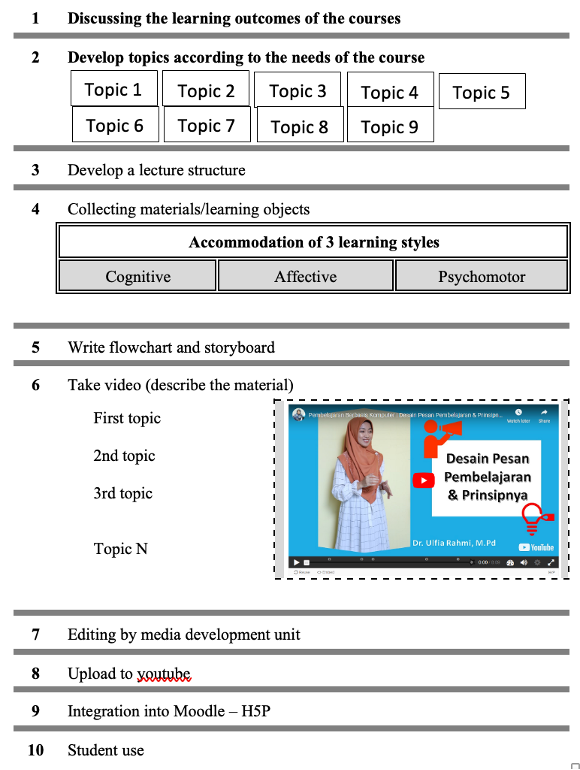
This study's sample was used for CBI students at the Educational Technology department. The classes were divided into three types: groups of lecturers and lecturers in class, collaborative working in small groups and autonomous usage of the LMS. The course was rotated on a weekly basis.
The 88 participants in this study were purposively selected students in the Educational Technology Department, Universitas Negeri Padang, Indonesia. The H5P-based interactive video was applied to the CBI class in the department. These were second-year students who had sufficient ability to use the LMS and the features provided.
The instrument included two questionnaires. They were students' perceptions of the use of H5P activities in e-learning in CBI courses, and questions in students’ final exam. The questionnaires used were modified from the H5P implementation evaluation instrument (López et al., 2021), with numerous questions added to meet the research aims. The aspects evaluated in this study included: the usefulness of learning objects (seven items), integration of learning objects (four items), impact on learning (five items) and characteristics of learning objects (four items). The product moment approach was used to test the instrument again, and the findings returned for all items with a value of 0.05 were considered legitimate. Furthermore, the Cronbach's alpha reliability test yielded 0.963 > r table 0.202. This indicates that the instrument is trustworthy. Furthermore, the questionnaire data was examined using the bivariate Pearson correlation approach.
The result of the study indicated that there were three sections of interactive content with H5P: analysis, development, and evaluation. In the analysis part, the study included nine talking-head videos taken from scenarios prepared based on the objectives of CBI lectures in Padang State University's Education Technology study programme. The video lasted 64.41 minutes, or one hour, four minutes and four seconds in total. Students used a blended learning rotation model to follow CBI (see Figure 3).
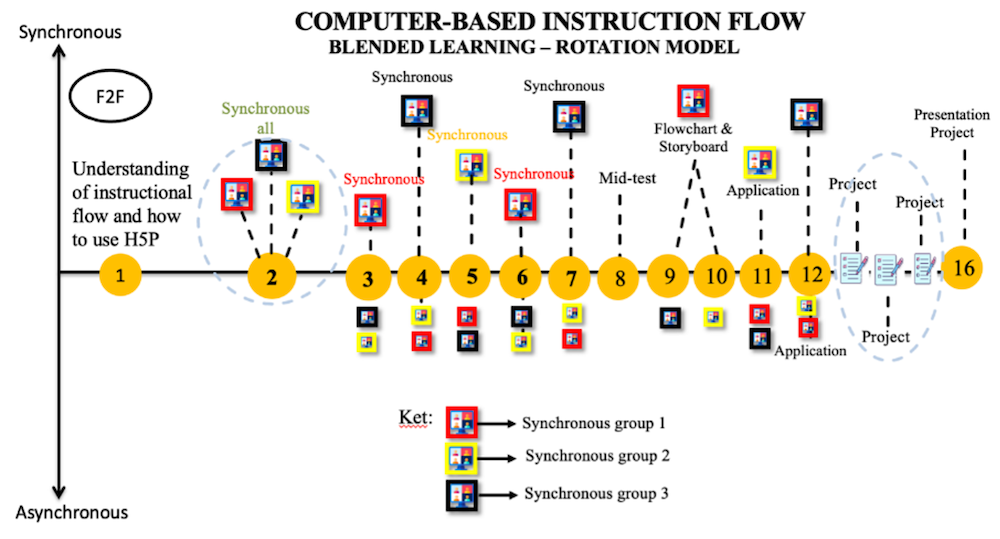
The chart shows three groups: lecturer (1), LMS (2) and collaborative (3). The lecturer group participated in activities with lecturers, the LMS group participated in Moodle activities with interactive material, and the collaborative group participated in activities connected to the process of building CBI with their groups. The interactive content consisted of nine videos. They were divided into three categories: CBI principles, methods and models. Each video included an activity that allowed the video and the user to interact. Multiple-choice questions, multiple choice, single choice, true and false, short responses, drag and drop, fill-in-the-blank, statements, labels and text were all interwoven into the video. Students received scores from the questions that emerged while utilising H5P. Figure 4 depicts the interactive video in this study with a mixed learning rotation approach.
Then, in the development section, there were nine interactive videos that enabled blended learning activities based on idea mapping. The H5P plugin included interactive content and quiz types. After that, the developers created the mapping concept and constructed the video scene. The fundamental aspect of delivering material and kinds of action in interactive content was material quality (Mayer, 2021).
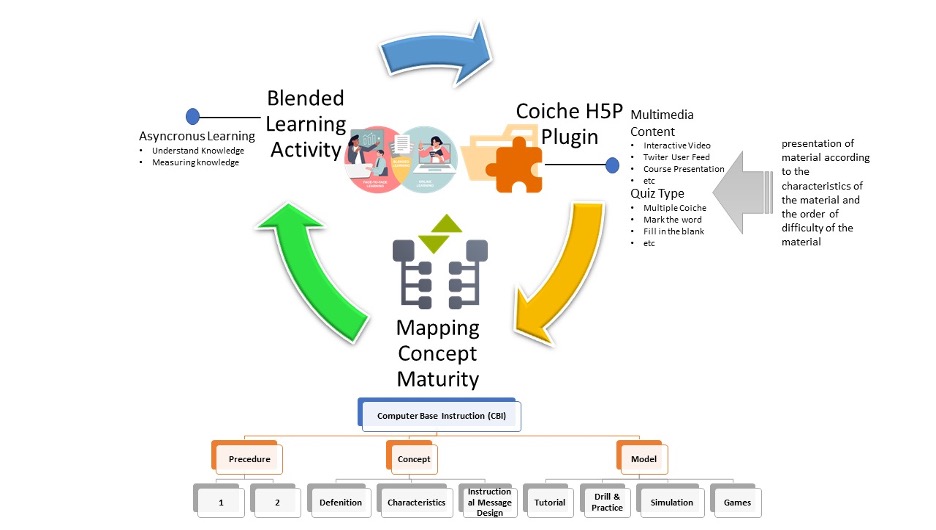
The mapping in Figure 4 shows that there were nine interactive videos to support blended learning activities. The scenario for using H5P for each group followed the rotation model in Figure 3. The following is the number of students who accessed H5P content in the learning management system. On average, each video was accessed by more than 88 students. The following is the number of students who accessed H5P content on the learning management system. On average, each video was accessed by more than 88 students. The average of students’ achievement using H5P video can be seen in Figure 5.
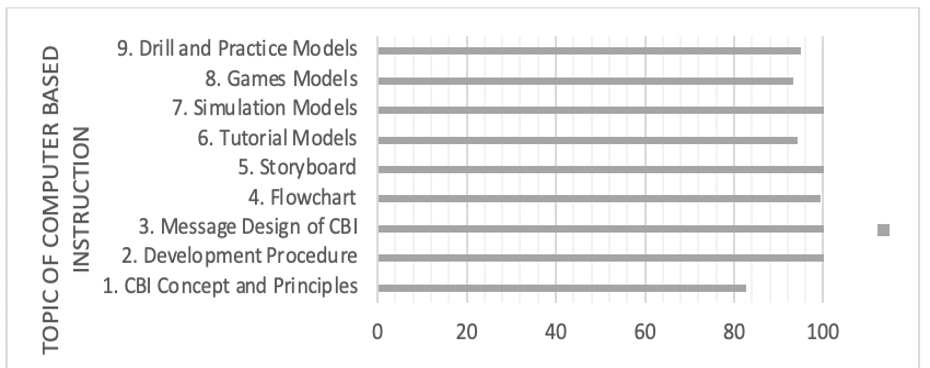
The nine videos that represented H5P content in the courses had varying amounts of access from students. The amount of access by students was influenced by how long they had known about the interactive content from H5P. The many H5P content accesses can be seen in more detail in the following graph (Figure 6).
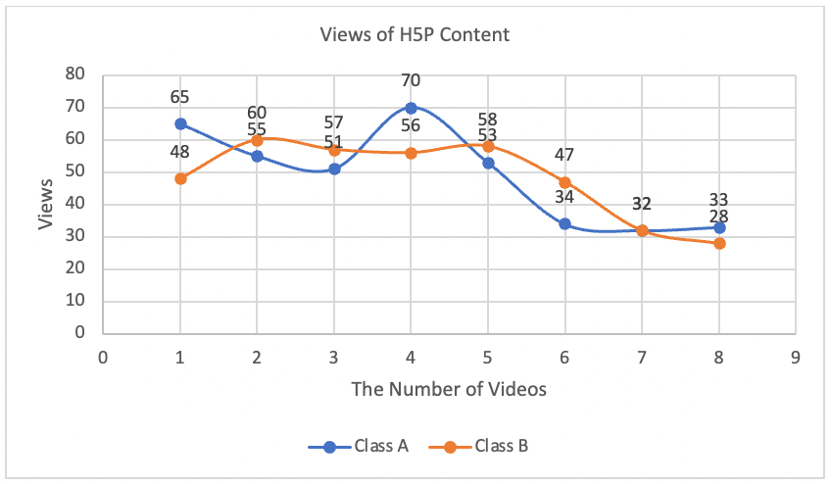
As seen in Figure 6, students’ access to H5P content decreased with the frequency of viewing the content presented. At the beginning of the H5P content, the frequency reached 65 views from 20 students, or, on average, almost every student accessed the content up to three times. This is because at the initial stage, the content has to be understood technically by the students. The ability to use technological tools was also influenced by the iterative process.
The H5P content uploaded at the next meeting exhibited a reduction in the frequency of visits, such as interactive video content on game models, which was only accessed 28 times by 21 students. This shows that students were becoming increasingly familiar with using H5P content. Based on the use of the H5P content, students were then asked to give their perception of the content. Then students' perceptions and scores at the end of the use of content were analysed, using the ANOVA technique, to reveal whether there was a linear relationship between perceptions of using H5P and learning outcomes scores from the questions presented on H5P. The results of the linearity test can be seen in Table 1.
Table 1: The Results of the Linearity Test of Student Learning Outcomes

With a deviation from the linearity value from the sig value (0.880) to the F value (0.526), it can be concluded that the perception variable had a linear relationship with the learning outcome variable. The linearity value was also seen from the calculated F value (0.526) < F table (1.92); hence, it can be said that the variables had a linear relationship. Furthermore, the correlation test between perceptions and learning outcomes was carried out on each H5P piece using the Pearson Bivariate Correlation Test. The result can be seen in Table 2, which shows the perception and learning outcome:
Table 2: The Significance Value of the Correlation between Student Perceptions of H5P and Learning Outcomes

The sig values of perception and LO were 0.00 < 0.05. This means that there was a significant correlation between perception and LO. The Pearson correlation value of perception and LO was 0.503 > the table r value of 0.213. This can be interpreted as meaning that the relationship between X and Y had a meaningful correlation. For more detail regarding student perceptions of the use of H5P activities based on the results of the data analysis obtained, see Table 3.
Table 3. Students' Perceptions of the use of H5P Activities in e-Learning in Computer-Based Learning Courses
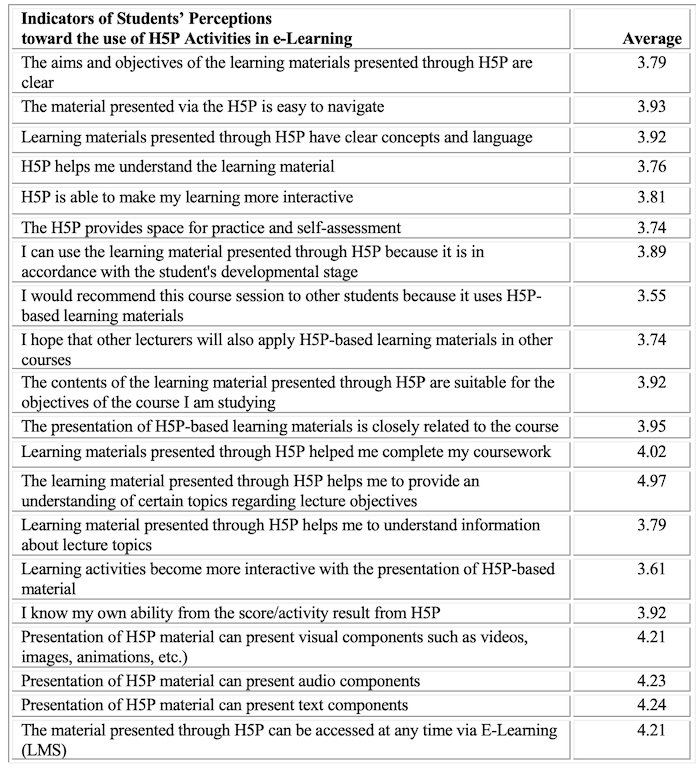
Based on the results of the analysis of student perception data on the use of H5P activities in e-learning in CBI courses, students positively responded to the use of H5P activities in e-learning. The highest average was 4.97, where students thought that the learning material presented through H5P helped them understand certain topics about lecture objectives. Besides that, students had a positive opinion that the H5P activity in e-learning had features that were complemented by audio, visuals and text. Students also thought that they could immediately see the results of this H5P activity, and the material presented could also be accessed at any time through e-learning. Furthermore, students also gave a positive response to the H5P activity in e-learning towards learning materials, where learning using this H5P activity in CBI courses helped them understand the material, was more interactive and helped them complete lecture assignments. In addition, H5P also gave them space to self-evaluate so that they could find out what abilities and things could be improved in the future. The results of this questionnaire analysis were in line with the results of interviews with several students, where they argued that this H5P activity in CBI subjects was very easy to apply and helped them understand the material, but they also argued that the H5P activity in e-learning was still difficult to implement using a mobile phone and was sometimes constrained by the network.
The results of this study present a comprehensive approach to converting pre-existing CBI into active learning with interactive content using H5P via Moodle. In this study, the interactive content was integrated into a blended learning framework with a rotation model. The researcher combined all learning resources between the H5P technical process, the rotation model flow and the characteristics of CBI (the mapping concept). Interactive content was developed using the proposed flow to produce interactive content that fitted students’ needs. Then the material was mapped and the video script was designed. Moreover, video shooting was carried out by talented lecturers who taught CBI. Editing is a time-consuming process that requires collaboration between the internal media development unit, educational technologies and lecturers.
The utilisation of H5P in implementing blended learning with the rotation model could be a solution to the challenges and limitations identified in CBI courses. The rotation model applied to classes where students need independent learning has also proven the success of this model in the application of blended learning (Nurkamto et al., 2019). This rotation model is one of the most popular blended learning models (Ashraf et al., 2021). Limitations that can be overcome by using H5P-based content include the need for material flexibility, interactive content, independent learning and building new knowledge (Wang, 2017; Dewan & Steeleworthy, 2013; Mestre, 2012). The advantages of this research, apart from offering a rotation model scenario in blended learning, also convey the flow of how to develop H5P-based interactive content. In the flow of important content development, media designers, instructional designers, content developers, and learning evaluators pay attention to instructional message design (Rahmi & Azrul, 2021b; Ramlatchan, 2021). This is important to pay attention to because the characteristics of interactive content vary. The advantage is that interactive content and support for interesting and challenging learning scenarios complement the application of blended learning (Dwivedi et al., 2019; Bouilheres et al., 2020). Furthermore, the results of this study were still limited to the use of H5P content in the application of the blended learning rotation model with scenarios that matched the characteristics of the content in CBI courses. The use of H5P content could improve collaboration and communication, which can help develop students' social and interpersonal skills (Suprabha & Subramonian, 2021). Also related to the results of this study is the H5P content with the Rotation model will have implications for the effective use of technology (Anthony et al., 2019). For users in educational institutions, utilising technology is a more effective method for learning.
The results of this research were seen from students' perceptions of the use of H5P with the Rotation Type Blended Learning model. The results of data analysis from students' perceptions of using H5P activities in CBI courses showed positive results. The students felt the benefits in using video interactive H5P activities in the courses. The H5P activity helped them to understand the lecture objectives and the material presented. This is in line with several previous studies conducted where the object characteristics of the H5P have proven successful in improving and achieving lecture goals (Lopez, 2013). In addition, it is important that the material be presented in an interactive and interesting manner in order to create active and meaningful learning (Dewan & Steeleworthy, 2013; Mestre, 2012; Rahmi & Azrul, 2019). This H5P activity was also useful because students could evaluate their understanding on the lesson content. Baruque, et al., (2003) also found that using H5P is recommended because it can build self-assessment activities to encourage students to learn new knowledge. H5P activity is also supported with complete features, such as images, audio, video and text. Thus, H5P activity in e-learning, provides a more interactive, creative and meaningful learning process. However, there are several obstacles found when H5P is used on a mobile phone, including network problems and the demands imposed by the use of the activity. The same thing was found by Dhini & Ardiasih, (2021), where the students found it difficult to use H5P, since it requires a good internet package and takes time to operate.
The implications of the study apply especially to policy makers in higher education, and higher education institutions that use Moodle as an LMS platform. The LMS requires the H5P plugin through LMS developers so that lecturers can prepare interactive content in the implementation of asynchronous online material. For lecturers to have interactive content, they need to follow the interactive H5P content development model to present interesting content for students This has to be done because it has been shown that H5P content builds positive perceptions and improves learning outcomes. Furthermore, researchers in this field need to expand the sample and variety of blended learning types to further prove the effectiveness of H5P content.
The contribution of this study to existing knowledge is that the elaboration of the development steps makes the flow more specific, especially in: a) topic mapping so that there is no overlapping content (step 2), b) considering learning message design principles (all steps), and c) integrating interactive content into the rotation model of blended learning activity. This means the syntax of this rotation model could be used for various other courses. In addition, the interactive video content indicates that there is a significant relationship between student perceptions of interactive videos and learning outcomes, unlike one-way videos. The need for interactive video content is increasingly needed because students, as active users of technology in their daily lives, receive interesting short video content. Students can view the video for a long time, and this becomes a challenge for how to present interesting and challenging learning content to complete student learning tasks.
The limitation of this study is the number of participants found in Universitas Negeri Padang was quite small. In fact, the classes totalled only 10593, and the users of H5P represented only nine classes. This was 0.085 % of all the classes. Also, the participants were limited to only CBI classes with characteristics of concept understanding and project work that were relevant to the learning outcomes.
Thus, it is suggested that further research should have a larger sample in order to accommodate the differences of students’ characteristics. There is a probability that a small number of participants did not represent all students’ characteristics. This led to a result lacking variability. In future, H5P should be applied to numerous courses in order to measure the effectiveness of H5P in other courses.
Finally, H5P contributed to the creation of interactive content that led to a more effective learning outcome. The effectiveness can be seen from the positivity of students’ perception on learning content that gave impacts on students’ performance. Thus, in order to optimise H5P for interactive contents, the procedures in this research are an option to be considered.
Acknowledgment: The authors would like to thank Direktorat Riset dan Pengabdian Masyarakat, Deputy for Research and Development Strengthening, National Research and Innovation Agency, Indonesia with Universitas Negeri Padang with a contract number 039/E5/PG.02.00.PL/2023.
Adams, N.E. (2015). Bloom’s taxonomy of cognitive learning objectives. Journal of the Medical Library Association: JMLA, 103(3), 152.
Akram, M., Ather, H.M., Tousif, M., & Rasul, S. (2012). The perception of teachers in using computer-based technology at higher education. International Journal of Social Sciences & Education, 2(1).
Al-Ajlan, A., & Zedan, H. (2008). Why moodle. 2008 12th IEEE International Workshop on Future Trends of Distributed Computing Systems, 58-64.
Alexe, C-G., Alexe, C-M., Dumitriu, D., & Mustață, I.C. (2021). Online review management on SAAS comparison platforms: Case study capterra. ELearning & Software for Education, 2.
Altinpulluk, H., & Kesim, M. (2021). A systematic review of the tendencies in the use of learning management systems. Turkish Online Journal of Distance Education, 22(3), 40-54.
Anthony, B., Kamaludin, A., Romli, A., Raffei, A.F.M., Nincarean A.L Eh Phon, D., Abdullah, A., Ming, G.L., Shukor, N.A., Nordin, M.S., & Baba, S. (2019). Exploring the role of blended learning for teaching and learning effectiveness in institutions of higher learning: An empirical investigation. Education and Information Technologies, 24, 3433-3466.
Ashraf, M.A., Yang, M., Zhang, Y., Denden, M., Tlili, A., Liu, J., Huang, R., & Burgos, D. (2021). A systematic review of systematic reviews on blended learning: Trends, gaps and future directions. Psychology Research and Behavior Management, 1525-1541.
Benkada, C., & Moccozet, L. (2017). Enriched interactive videos for teaching and learning. 2017 21st International Conference Information Visualisation (IV), 344-349.
Bentri, A., Hidayati, A., & Rahmi, U. (2016). Students absorption of materials through using blended learning in the implementation of curriculum. International Journal Advances in Social Science and Humanities Alwen Bentri, 4(10), 1-7.
Bouilheres, F., Le, L.T.V.H., McDonald, S., Nkhoma, C., & Jandug-Montera, L. (2020). Defining student learning experience through blended learning. Education and Information Technologies, 25, 3049-3069.
Clark, R.C., & Mayer, R.E. (2016). E-learning and the science of instruction: Proven guidelines for consumers and designers of multimedia learning. John Wiley & Sons.
Costa Dias, M., Joyce, R., Postel‐Vinay, F., & Xu, X. (2020). The challenges for labour market policy during the Covid‐19 pandemic. Fiscal Studies, 41(2), 371-382.
Dewan, P., & Steeleworthy, M. (2013). Incorporating online instruction in academic libraries: Getting ahead of the curve. Journal of Library & Information Services in Distance Learning, 7(3), 278-296.
Dhini, B.F., & Ardiasih, L.S. (2021). Enhancing learners’listening skills with H5P: A Moodle-based online learning platform. Full Papers of The, 169.
Drysdale, J.S., Graham, C.R., Spring, K.J., & Halverson, L.R. (2013). An analysis of research trends in dissertations and theses studying blended learning. The Internet and Higher Education, 17, 90-100.
Dwivedi, A., Dwivedi, P., Bobek, S., & Zabukovšek, S. S. (2019). Factors affecting students’ engagement with online content in blended learning. Kybernetes.
Fleming, M.L. (1993). Instructional message design: Principles from the behavioral and cognitive sciences. In Educational technology.
Giannakos, M.N., Krogstie, J., & Sampson, D. (2018). Putting flipped classroom into practice: A comprehensive review of empirical research. Digital Technologies: Sustainable Innovations for Improving Teaching and Learning, 27-44.
Gil‐García, I.C., Fernández‐Guillamón, A., García‐Cascales, M.S., & Molina‐García, Á. (2023). Virtual campus environments: A comparison between interactive H5P and traditional online activities in master teaching. Computer Applications in Engineering Education, 31(6), 1648-1661.
Jacob, T., & Centofanti, S. (2023). Effectiveness of H5P in improving student learning outcomes in an online tertiary education setting. Journal of Computing in Higher Education. https://doi.org/10.1007/s12528-023-09361-6
Kömür, İ.A., Kilinç, H., & Okur, M.R. (2023). The rotation model in blended learning. Asian Journal of Distance Education, 18(2), 63-74.
Lopez Islas, J.R. (2013). Digital literacy and academic success in online education for underprivileged communities: the prep@ net case. [Docotral Dissertation, The University of Texas, Austin].
López, S-R. R., Ramírez, M-T. G., & Rodríguez, I-S. R. (2021). Evaluation of the implementation of a learning object developed with H5P technology. Vivat Academia, 24(154), 1-23.
Mayer, R.E. (2021). Evidence-based principles for how to design effective instructional videos. Journal of Applied Research in Memory and Cognition, 10(2), 229-240.
Mestre, L.S. (2012). Student preference for tutorial design: A usability study. Reference Services Review, 40(2), 258-276.
Mir, K. (2021). H5P Interactive video content in Moodle to improve learners’engagement in online learning. Full Papers of The, 403.
Nurkamto, J., Mujiyanto, J., & Yuliasri, I. (2019). The implementation of station rotation and flipped classroom models of blended learning in EFL learning. English Language Teaching, 12(12), 23-29.
Oguguo, B.C.E., Nannim, F.A., Agah, J.J., Ugwuanyi, C.S., Ene, C.U., & Nzeadibe, A.C. (2021). Effect of learning management system on students’ performance in educational measurement and evaluation. Education and Information Technologies, 26, 1471–1483.
Rahmi, U., & Azrul, A. (2022). Optimizing the discussion methods in blended learning to improve student’s high order thinking skills. Pegem Journal of Education and Instruction, 12(3), 190-196.
Rahmi, U., & Azrul, A. (2021a). Message design of printed and digital material to meaningful learning. Al-Ta Lim Journal, 28(1), 26-34.
Rahmi, U., & Azrul, A. (2021b). Message design of printed and digital material to meaningful learning. Al-Ta Lim Journal, 28(1), 26-34.
Rahmi, U., & Azrul, A. (2019). Diagnosing the quality of the discussions in blended learning: An effort to augment the students’ Higher Order Thinking Skills (HOTS). International Journal of Scientific & Technology Research, 8(11), 1124-1127.
Rahmi, U., Azrul, A., & Mahande, R.D. (2022). The prototype of blended learning’s support system to improve the pre-service teacher’s digital literacy. The Journal of Educators Online, 19(3). https://doi.org/https://doi.org/10.9743/JEO.2022.19.3.5
Rahmi, U., Mawardi Effendi, Z., & Ansyar, M. (2017). The development of message-design model in blended learning. The Asian Journal of Technology Management, 10(1), 1-9. https://doi.org/10.12695/ajtm.2017.10.1.1
Rohman, A., Arif, I., Harianti, I., Surohman Hidayat, A., Anselmus Teniwut, W., Nuraini, Inderawati, Baharun, H., Nurhidayah, Dja’Wa, A., Rahmi, U., Rudiantho Saragih, J., Burhanudin, J., Gumelar, G., Listyorini, T., Agustin, T., Nailah Zamnah, L., Yamin, M., Taufik Qurohman, M., … Suradi, A. (2019). ID3 algorithm approach for giving scholarships. Journal of Physics: Conference Series, 1175(1). https://doi.org/10.1088/1742-6596/1175/1/012116
Sergis, S., & Sampson, D.G. (2017). Teaching and learning analytics to support teacher inquiry: A systematic literature review. In Learning analytics: Fundaments, applications, and trends: A view of the current state of the art to enhance e-learning, 25-63.
Singh, S., & Scholz, K. (2019). Using an e-authoring tool (H5P) to support blended learning: Librarians’ experience. ASCILITE 2017 — Conference Proceedings — 34th International Conference of Innovation, Practice and Research in the Use of Educational Technologies in Tertiary Education, 158-162.
Sobchenko, T. (2021). Choice of blended learning models for higher pedagogical education students.Физико-Математическое Образование, 2(28), 17-21.
Suprabha, K., & Subramonian, G. (2021). Blended learning instructional strategy interventions for higher secondary school students: A focus on social skills. I-Manager’s Journal of Educational Technology, 17(4), 55.
Syafril, S., Rahmi, U., & Azrul, A. (2022). The development of case study teaching materials for prospective teachers in LPTK. Pegem Journal of Education and Instruction, 12(2), 193–199. https://doi.org/https://doi.org/10.47750/pegegog.12.02.19
Syafril, S., Rahmi, U., & Azrul, A. (2022). The development of case study teaching materials for prospective teachers in LPTK. Pegem Journal of Education and Instruction, 12(2), 193-199. https://doi.org/https://doi.org/10.47750/pegegog.12.02.19
Ti-Shen, E.T., & Sen, A. (2019). Effective use of interactive videos as an educational tool in higher education–An Asian context. EDULEARN19 Proceedings, 10379–10385.
Truitt, A.A., & Ku, H-Y. (2018). A case study of third grade students’ perceptions of the station rotation blended learning model in the United States. Educational Media International, 55(2), 153-169.
Wang, F.H. (2017). An exploration of online behaviour engagement and achievement in flipped classroom supported by learning management system. Computers & Education, 114, 79-91
Author Notes
https://orcid.org/0000-0002-5195-554X
https://orcid.org/ 0000-0002-0167-3253
https://orcid.org/ 0000-0003-2091-7302
Ulfia Rahmi completed a doctoral program in Education Science from Universitas Negeri Padang, where she is a lecturer in the Educational Technology Department. Her current research interests include blended learning and instructional design. She receives research funding each year from the university and the Ministry of Education. Email: ulfia@fip.unp.ac.id
Bayu Ramadhani Fajri has been a lecturer at Universitas Negeri Padang since July 2018. He was a staff member at SEAMEO SEAMOLEC (Southeast Asian Ministers of Education Organization Regional Open Learning Centre) in the IT Contents and Knowledge Management division. His research interests are: animations, virtual environments, augmented reality, virtual reality, edugame development, interactive media, simulation, programming and e-learning. Email: bayurf@unp.ac.id
Azrul Azrul received his Bachelor’s and Master’s of Educational Technology and completed his doctoral program in Education Science from Universitas Negeri Padang. He is a lecturer in Teacher Training and Education at Universitas Islam Negeri Imam Bonjol Padang. His current research interest include e-learning and instructional media. Email: azrul@uinib.ac.id
Cite as: Rahmi , U., Fajri, B.R., & Azrul, A. (2024). Effectiveness of interactive content with H5P for Moodle-learning management system in blended learning. Journal of Learning for Development, 11(1), 66-81.